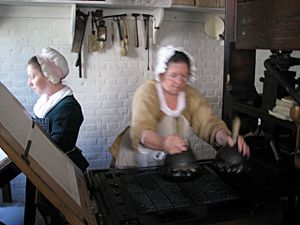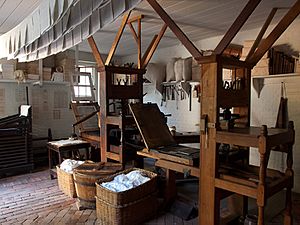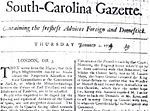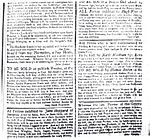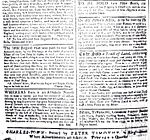Elizabeth Timothy facts for kids
Quick facts for kids
Elizabeth Timothy
|
|
|---|---|
| Born | c. 1700 |
| Died | 3 April 1757 (aged 54), buried 4 April 1757 |
| Resting place | St. Philip's Anglican Church cemetery, Charleston County, South Carolina, US |
| Occupation | printer |
| Known for | First American female publisher, first American female franchise holder |
| Spouse(s) | Louys Timothée or Lewis Timothy (b.1699) aka Louis Timothee |
| Children | Peter (b. 24 May 1725) Mary (b. 8 Dec 1726) Louis (b. 19 Jun 1729) Charles (b.14 Sep 1730) Catherine (b. 15 Jan 1735) Louisa (b. 6 Dec 1737) |
| Parent(s) | Claude Vilain Elizabet Graciot |
| Signature | |
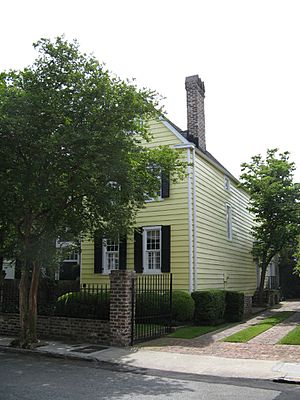
Elizabeth Timothy (around 1700 – April 1757) was a very important printer and newspaper publisher in early America. She lived in the colony of South Carolina. Elizabeth was a French Huguenot immigrant from the Netherlands. She came to America with her family.
She made history as the first American woman to publish a newspaper. She was also the first woman to hold a special business agreement called a franchise in America. Elizabeth Timothy reported on the big Charleston fire of 1740. This fire destroyed a large part of the town. She also printed government papers and other important documents. She even worked for the famous Benjamin Franklin.
Contents
Early Life and Family
Elizabeth Timothy, whose maiden name was Villin or Vilain, was born in the Netherlands around 1700. She went to school in her hometown in Holland. There, she learned important skills like accounting. She married Lewis Timothy in the early 1700s.
In 1731, the Timothy family traveled from Rotterdam to Philadelphia. They sailed on a ship called the Britannia of London. They were part of a group of French Huguenots seeking a new home. The family had four young children at the time. Their sons were Peter, Louis, and Charles. Their daughter was named Mary.
Starting a Business in America
Elizabeth's husband, Lewis, made a deal with Benjamin Franklin. This deal was to restart a weekly newspaper called the South Carolina Gazette. It was a six-year agreement, like a business partnership. Lewis went to Charleston first in late 1733. He started publishing the newspaper on February 2, 1734.
Elizabeth followed him later from Philadelphia. She arrived in Charleston in the spring of 1734. She brought their six children with her. Four of their children had been born in the Netherlands. Elizabeth's journey to becoming a newspaper publisher is closely tied to her husband's work.
Taking Over the Newspaper
On December 30, 1738, Elizabeth's husband died from yellow fever. This was a very sad event for the family. Because of the agreement with Franklin, Elizabeth decided to continue the business. She became his apprentice and partner. She wanted to finish the last year of the franchise agreement.
Her oldest son, Peter Timothy, was named as taking over the business. This was part of the agreement from 1733. But Peter was only fourteen years old in 1738. He was too young to run a business by himself. So, Elizabeth, his mother, managed everything.
She started publishing the South-Carolina Gazette weekly on January 4, 1739. The newspaper's masthead (the nameplate at the top) said "Published and printed by Peter Timothy." But Elizabeth was truly in charge. She ran the business so well that a year later, she bought Franklin's share. This made her the full owner. She became the first female editor and publisher of a newspaper in America.
Elizabeth, with Peter's help, made the newspaper better over time. Readers of the South-Carolina Gazette noticed the improvements. Her newspaper covered many topics. It included dramas, poems, and classic literature. She also printed news from Europe, like London and Paris. A very important part of her newspaper was the advertisements. They offered local goods, books, and stationery. Sometimes, a whole page of her four-page newspaper was filled with ads.
The Great Charleston Fire
One of the biggest news stories Elizabeth covered was the Charleston fire. It happened on November 18, 1740. Two days later, she reported that the fire had destroyed a huge part of the town. Many valuable buildings and goods were lost. The damage was worth more than 200,000 pounds sterling. She wrote that two-thirds of the town was gone. More than 300 houses were destroyed.
Her paper reported that the wind spread sparks, setting more houses on fire. She praised the people of Charleston for working hard to put out the fire. Her newspaper also shared a message for citizens. It asked them to help quickly in future fires. It also asked people to return any stolen items. In later newspapers, she printed notices about businesses moving. She also printed requests for help finding lost goods.
Praised by Benjamin Franklin
Benjamin Franklin spoke highly of Elizabeth. He said she was a better business manager and accountant than her late husband. In his Autobiography, Franklin wrote that her husband was educated but not good with money. He noted that in the Netherlands, women often learned accounting. Franklin also praised Elizabeth for raising honest and hardworking children. Historians believe her good business sense came from her excellent education in the Netherlands.
Elizabeth also took over her husband's job as the official public printer for South Carolina. She printed laws, acts, and news for the colony's Assembly. Besides the South-Carolina Gazette and government papers, she printed sermons and religious materials. Between 1739 and 1745, she published about 20 historical books and pamphlets. Even though "Printed by Peter Timothy" was on these publications, Elizabeth made most of the business decisions. She was also the postmaster for Charles Towne, South Carolina. She delivered letters, packages, and newspapers.
A New Career Path
When her son Peter grew up, he took over the printing business. This happened in 1746. Elizabeth then opened a bookstore right next door on King Street. She sold books, stationery, and writing supplies. These included ink, powder, and quills. She also sold items like tallow, beer, and flour.
In an advertisement in the Gazette in October 1746, she listed some of her items. She sold small Bibles, spelling books, and primers. She also sold full books by famous authors and Franklin's works. This included Poor Richard's Almanack. Elizabeth ran her bookstore for a year. Then, she decided to leave Charleston. Before leaving, she advertised in the South-Carolina Gazette. She asked people who owed her money to pay their debts. She moved to a new area for a while. Later, she returned to Charleston in 1756.
Death and Legacy
Elizabeth Timothy wrote her will on April 2, 1757. She passed away later that month. An inventory of her belongings listed "a parcel of books," including two French Bibles. It also showed furniture, jewelry, silver, and other household items. The total value was about £25.
Her will stated that her widowed daughter, Mary Elizabeth Bourquin, would receive land, a house, two slaves, and half her clothing and furniture. Her married daughters, Catherine Trezevant and Louisa Richards, would receive a house, three slaves, and the rest of her estate.
Elizabeth belonged to the Charleston Library Society. Her son Peter was one of its founders. She and her family were members of St. Philip's Anglican Church in Charleston. Historians note that Elizabeth's husband died in December 1738. Elizabeth was pregnant with her seventh child in 1739. Sadly, the child was born too early and did not survive. She also lost two sons to yellow fever in 1739. When Elizabeth died in 1757, she was survived by her son Peter and three daughters.
After her death, Elizabeth Timothy was honored for her achievements. She was inducted into the South Carolina Press Association Hall of Fame in 1973. In 2000, she was also inducted into the South Carolina Business Hall of Fame. There is a plaque in Charleston that describes her important role in journalism. Historians say Elizabeth Timothy was the first known female in American journalism. Because she took over her husband's newspaper business through a franchise agreement with Franklin, she was also the first female franchisee in America.
Works
The South Carolina Gazette newspaper from January 4, 1739, is an example of Elizabeth Timothy's work. She also printed colonial laws, bank notes, and other documents. She also started a bookstore.
-
Bottom part of the second page
News about Chief Red Shoes
The bottom right corner of the third page of this newspaper has the obituary for Elizabeth's husband. Benjamin Franklin often reprinted articles from Elizabeth's paper. The Gentlemen's Magazine in England also reprinted her work. She continued to publish the Gazette newspaper for 19 years after her husband passed away. Her son Peter later took over the business and ran it for many years.



